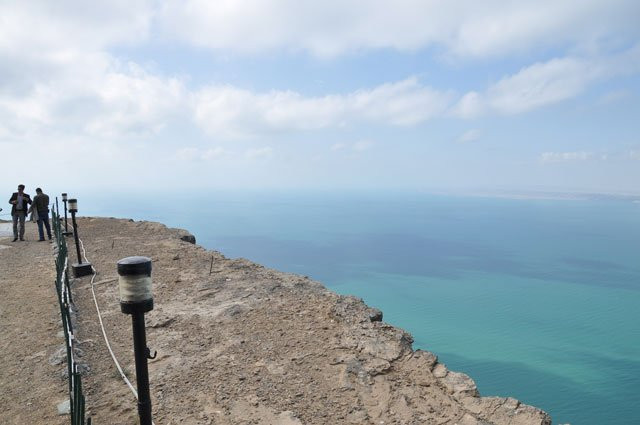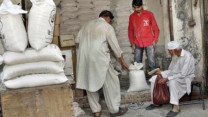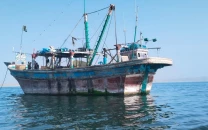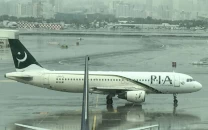Still waters: Pakistan’s coastline of apathy
Without holistic policy, 290,000sqkm of maritime zone suffering from gross negligence

PHOTO: Pakistan navy
Special marine battalion to protect Gwadar Port, Chinese engineers
Last year in March, 50,000 square kilometres of continental shelf was added to the country’s existing 240,000 square kilometres after its claim was accepted by the United Nation’s Commission on the Limits of Continental Shelf. As a result, Pakistan gained exclusive rights over the seabed and subsoil resources spread over 290,000 square kilometres in the Indian Ocean. The country’s sea limit was also extended from the existing 200 to 350 nautical miles.
 PHOTO: Pakistan navy
PHOTO: Pakistan navyLack of awareness about the importance of maritime, however, meant that barely anyone noticed this significant development achieved through tedious diplomatic efforts. Let alone exploiting subsoil resources, Pakistan has also failed to explore the full potential of seafood exports. An official study claims Pakistan’s coastal area produces more than 625,000 tonnes of fish, out of which only 131,000 tonnes is exported. If fully materialised, the exports can fetch an additional $2 billion. Moreover, according to WWF-P, approximately 1,000 species of fish and 12 species of cetacean, or marine mammals, are found in Pakistan’s waters.
 PHOTO: Pakistan navy
PHOTO: Pakistan navyThere are over 30,000 fishermen in Pakistan, with another 700,000 people associated with the trade. Many use trawlers and small nets to catch fish, a practice considered harmful for marine life. Unsustainable practices in fishing, destructive gear, uncontrolled fleet size, and poorly-planned development are other factors leading to untapped potential.
Fighting fit: A place of hope and healing
The developed coastal areas of Karachi and Port Qasim are facing an even graver threat. The sea there is being used a dumping ground for sewage and solid waste, resulting in heavy pollution at Karachi Harbour, Gharo and Phitti Creek.
Call of the deep blue
The sea is Pakistan’s lifeline for trade. More than 90% of the country’s trade with other countries along with all its oil imports are routed through the sea. By 2020, it is estimated that the volume of this trade will reach a staggering $100 billion. There is, however, a snag. Pakistan National Shipping Corporation, which is the national flag carrier, has only nine vessels, of which four are oil tankers. As a result, the country pays more than $4.5 billion to foreign freight carriers every year. In fact, having only four oil tankers of its own puts Pakistan in a vulnerable position, one an enemy state can easily exploit in the event of a conflict.
 PHOTO: Pakistan navy
PHOTO: Pakistan navyPakistan has had a shipyard since 1954. The shipping industry, however, has remained in disarray, with little heed paid to its upkeep. Fortunately, the government seems to be stirring from its slumber and is now in the process of reviving it. After the catastrophic oil spill in Karachi by the MV Tasman Spirit in 2003, an urgent need was felt for the formulation of a comprehensive anti-pollution plan.
Special operations: Pakistan, Bahrain hold joint naval drill
Subsequently, a comprehensive National Marine Disaster Contingency Plan (NMDCP) was prepared to deal with all marine disasters, including oil spills, search and rescue, and salvage operations. The execution of NMDCP was ordered by the chairman of the Pakistan Marine Disaster Management Board, which is headed by the Chief of Naval Staff.
Strategically, the location of Pakistan’s marine belt is very important for trade and oil supply routes from the Persian Gulf. It is also close to the Red Sea. This geographical advantage provides an opportunity for Pakistan to dominate the crucial stretch of the coastal belt and vital routes across the Arabian Sea. The lack of a holistic policy, however, is hampering progress.
During a recent media interaction, Vice Admiral Syed Arifullah Hussaini put it best when he paraphrased Sir Walter Raleigh, saying: “The nation that rules the sea, rules the world.” He stressed the maritime policy is directly linked to the industrial policy, "If we want to strengthen our security, we would have to improve our economy."


















COMMENTS
Comments are moderated and generally will be posted if they are on-topic and not abusive.
For more information, please see our Comments FAQ